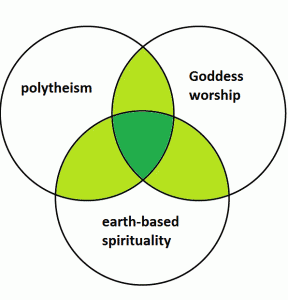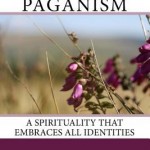I was very pleased to read P.S.V. Lupus’ article today emphasizing the importance of polytheism for Paganism (“Bringing Back the Gods”). I agree that polytheism as a theological viewpoint and as an underlying theory for Pagan religious practice is one of the unique contributions the Pagan movement has to make to contemporary religion.
In the circuitous route I took to my current religious practice, I’ve assumed a more and more polytheistic worldview — not for ideological reasons or out of an active rejection of my birth religion, but because in my spiritual explorations, polytheistic practices produced deeper, more transformative, and more ecstatic experiences. I came to Paganism because I was looking earnestly for intimacy with the divine, not so much because of an innate attraction to pre-Christian mythologies or to any particular named deity. Finding myself cultivating a polytheist practice was, therefore, not what I’d expected to be doing — but it’s what I find most meaningful.
Let’s back up a minute and define some terms. When I say “polytheist,” what I primarily mean is the position that the gods are individuals, volitional and unique beings much like individual humans, and should be treated as such. This position is often called hard polytheism. Soft polytheism is the idea that there are many gods, but they are aspects of one God/dess, or sometimes a Goddess and a God.
This is one area where my theology and practice don’t perfectly match. My personal practice is structured on hard polytheist principles — the gods have names and personalities, and human beings can have relationships with them. My theology, however, is a messy mix of monism (all things are made of one essence and so have an underlying unity) and both kinds of polytheism. That messiness is based on experience, because the gods are not content to reveal themselves in only one way: for me, they are sometimes distinct, and they sometimes blur into each other unpredictably. At other times, I have experiences of a unified divine force that transcends even the permeable boundaries that soft polytheism imagines.
This inconsistency, as far as I’m concerned, is normal. The point of articulating a theology isn’t to pin down an unchanging theological perspective. It’s to give us a vocabulary to describe our experiences and allow us to discuss our beliefs and practices — and hopefully, therefore, to find both common ground and respectful understandings of difference.
In any case, to come back to PSVL’s article: I agree, bringing back the gods is one of the points of contemporary Paganism. Pagans should not be ashamed to be polytheists, and they should engage sophisticated theological resources (such as the polytheistic theologies of the ancient Greeks or contemporary process theology) to explore what that stance means intellectually, spiritually, and practically.
All that being said: I don’t think you have to be a polytheist to be Pagan.
Today, in 2013, I think the three legs of the contemporary Pagan cauldron are these: polytheism, Goddess worship,* and earth-based spirituality. These three focuses for belief and practice have all contributed to what we think of as Paganism. Within the movement, a great many practitioners embrace all three perspectives, and many also engage two of the three.

Because this makes for a diverse set of attitudes, beliefs, and concerns, though, the outliers in this Venn diagram tend to struggle with the idea of “Pagan” identity. Pagan identity is most stable where the three categories overlap. Polytheists who aren’t particularly earth-based or interested in gender politics may feel marginalized, as may indoor worshippers of “the Goddess.” Those practicing “deep ecology” — a nature-based spirituality that has little to do with deities at all — may also feel out of place in the Pagan midst.
It helps to talk about this situation openly, and about the fact that in its modern context, Paganism is an umbrella movement of associated religious traditions, not a fully-formed religious tradition in and of itself. Different Pagan communities tend to lean toward one or two of the above categories without being explicit about their orientation, which can lead to a mysterious sense of alienation among those individuals who came expecting the third. Unspoken and unmet expectations are one of the most common sources of conflict in communities, and yet we Pagans are inconsistent about accurately setting each others’.
So when PSVL says that Pagans describe themselves as nature worshippers because they’re attempting to make people of other religions more comfortable, he may be right for some Pagans at some times. But as many polytheists are disappointed to realize, for some Pagans, polytheism is not a main focus for practice or belief.
I’m speaking as someone who doesn’t really have a horse in the “defining Paganism” race. I’m a nature-based polytheist who came to Paganism first through feminist spirituality, which means I sit squarely in the middle of the cauldron and find myself comfortable in most Pagan groups. But my Paganism has been informed by practitioners who fall all over that Venn diagram. Some of the most potent practitioners I’ve known have been non-theist animists, urban polytheists, and Jungian spiritual feminists — and I was lucky enough to meet them because we gathered under a “Pagan” umbrella.
As much as I’m dedicated to the development of Pagan theology, I’d like us to avoid labeling ourselves too much as “-ists” of any type. Those words are better suited to describing our beliefs than our selves. Rather, I’d like to focus more on the threads we have in common and the activities we want to do together, employing our theological vocabulary to communicate with each other more clearly. (For example: if I’m going to attend a ritual given by a local group of Pagans who are nontheists, it helps set my expectations to know that going in — I’ll understand their ritual choices better and enjoy myself much more.)
Pagan polytheists should focus on bringing back the gods, and no doubt some of the more nature-based or feminist-focused Pagans will come along for the ride. But I don’t think we all need to be working on the same project to cheer each other on, or to form a meaningful community.
*In another post, perhaps, I’ll talk more about Paganism, Goddess worship, and gender. I think it’s not just feminist spirituality that is a persistent thread in Paganism, but rather an entire project involving the sacred exploration and redefinition of traditional gender roles. Historically speaking, the Goddess spirituality of the 1970s and 1980s did much to define Paganism as we understand it today, but queer and transgender approaches to Paganism may be feminist spirituality’s contemporary heirs.











